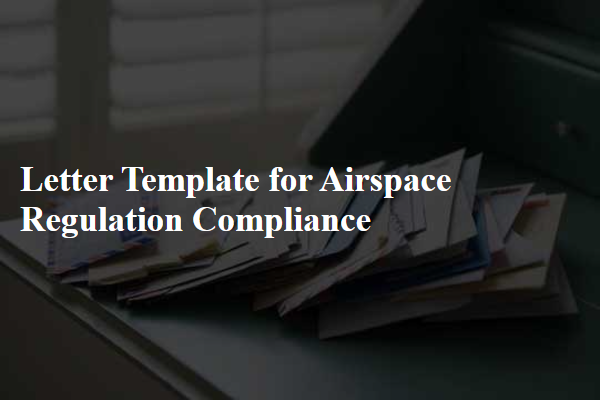Are you navigating the often complex world of airspace regulations and compliance? Understanding the ins and outs of these requirements can feel overwhelming, but it's essential for ensuring safe and efficient operations in our skies. In this article, we'll break down the key components of airspace regulation compliance and provide you with practical insights to help streamline your processes. So, buckle up and join us as we explore this critical topic further!

Regulatory Authority Details
Airspace regulation compliance requires adherence to comprehensive guidelines established by regulatory authorities, such as the Federal Aviation Administration (FAA) in the United States or the European Union Aviation Safety Agency (EASA) in Europe. These organizations stipulate numerous regulations that govern commercial and private flight operations, including requirements for pilot certifications, airworthiness of aircraft, and adherence to designated airspace classifications such as Class A, B, C, D, and E. They also issue Notices to Airmen (NOTAMs) that inform pilots of temporary flight restrictions (TFRs) resulting from events like natural disasters or special events. Compliance with these regulations is crucial for ensuring safe and efficient use of national and international airspace, ultimately helping to prevent aviation accidents and enhance operational efficiency.
Aircraft Identification and Details
Aircraft identification plays a critical role in ensuring airspace regulation compliance. Each aircraft is assigned a unique registration number, typically consisting of a country prefix followed by a series of alphanumeric characters; for example, N12345 for the United States. Detailed specifications include the aircraft type, such as Boeing 737 or Cessna 172, and the manufacturer, which contributes to safety evaluations. The maximum takeoff weight (MTOW) significantly impacts weight restrictions in various airspace classes. Additionally, the aircraft's transponder certification, which ensures accurate tracking by radar systems, is essential for maintaining situational awareness among air traffic control. Regular maintenance records and adherence to airworthiness directives issued by regulatory bodies like the Federal Aviation Administration (FAA) or the European Union Aviation Safety Agency (EASA) further strengthen compliance with airspace regulations.
Compliance Statement
Airspace regulation compliance ensures the safety and efficiency of aerial operations in controlled airspaces, such as class B airspace over major metropolitan areas like Los Angeles International Airport (LAX). Operators must adhere to Federal Aviation Administration (FAA) regulations, including maintaining communication with Air Traffic Control (ATC) and broadcasting positions on automatic dependent surveillance-broadcast (ADS-B). Compliance involves understanding sectional charts, altitude restrictions, and no-fly zones, which are crucial for preventing mid-air collisions. Operators must also ensure that their aircraft, whether manned or unmanned, possess valid airworthiness certificates and comply with specific operational guidelines outlined in Part 107 for drones. Regular audits and training programs must be conducted to ensure that personnel are proficient in airspace protocols, thereby promoting aviation safety and regulatory adherence.
Flight Operation Description
Flight operation descriptions must adhere to stringent airspace regulations outlined by governing bodies such as the Federal Aviation Administration (FAA) in the United States. Each operation begins with a thorough briefing on the specific airspace classification, whether it is Class A, B, C, D, or E airspace, affecting communication protocols and altitude restrictions. Operational parameters include the type of aircraft utilized, such as commercial jetliners like the Boeing 737, or general aviation planes such as the Cessna 172, with detailed specifications regarding maximum takeoff weight, cruising speed, and passenger capacity. The route's altitude profile ensures compliance with minimum safe altitudes and air traffic control (ATC) routing requirements. Each flight plan must outline departure and arrival airports, such as Los Angeles International Airport (LAX) or John F. Kennedy International Airport (JFK), along with intended waypoints, estimated time of arrival (ETA), and proposed flight level, typically ranging from 1,000 to 10,000 feet above sea level. Safety protocols must include traffic collision avoidance systems (TCAS) engagement and regular communication with ATC to ensure seamless integration within the National Airspace System (NAS).
Contact Information and Signatory
Submitting documentation for airspace regulation compliance requires detailed contact information and a designated signatory. The contact information must include the full name, title, organization name (e.g., Federal Aviation Administration), address (such as 800 Independence Avenue, SW, Washington, D.C.), telephone number (including area code), and email address. Providing accurate and up-to-date contact details ensures efficient communication regarding compliance matters. The signatory should be an authorized representative of the organization, who has the authority to bind the entity legally, ensuring signature authenticity. This representative's title should reflect their role, demonstrating their capability to handle regulatory communications effectively. Proper identification of the contact and signatory streamlines the compliance process and facilitates adherence to airspace regulations set forth by aviation authorities.













Comments